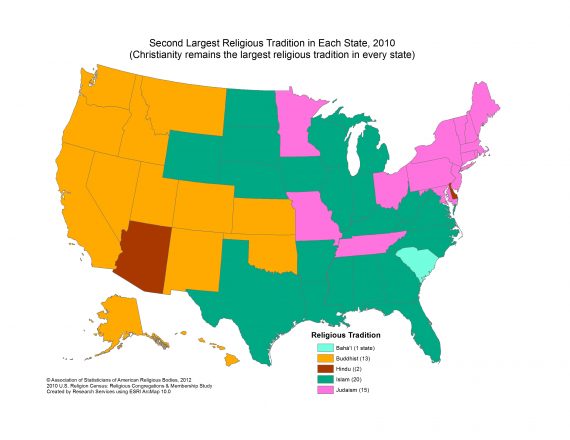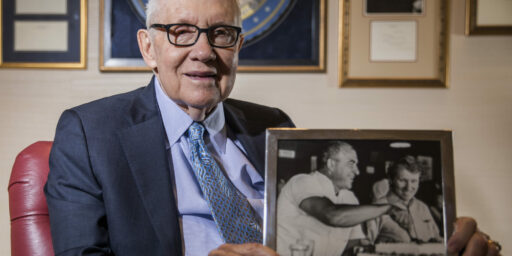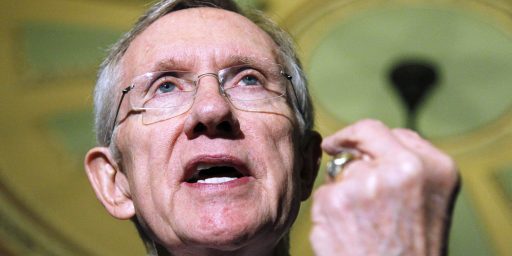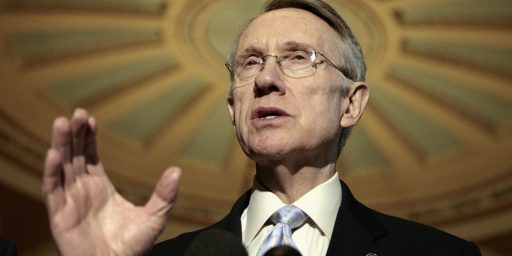The Second-Largest Religion By State
Reid Wilson takes a look at the map above (click to enlarge), which shows the second-largest religion in each state:
In the Western U.S., Buddhists represent the largest non-Christian religious bloc in most states. In 20 states, mostly in the Midwest and South, Islam is the largest non-Christian faith tradition. And in 15 states, mostly in the Northeast, Judaism has the most followers after Christianity. Hindus come in second place in Arizona and Delaware, and there are more practitioners of the Baha’i faith in South Carolina than anyone else.
Not entirely surprising, I suppose. Although one wonders how South Carolina became an outpost for the Bahai’.







Baha’i have been active in South Carolina for over 100 years:
http://www.pluralism.org/profiles/view/72389
I think there are two problems with the map. First, I strongly suspect that “no affiliation/atheist” is the second largest religion in many if not most states.
Second, it distorts reality. I don’t know about the other states and I don’t have the data for 2010 readily at hand but in 2000 in Illinois there were about 3.5 million Catholics, considerably more than the sum of all other religions and denominations. There were about 360,000 Methodists and about 350,000 Jews. In other words, not only were Christians the most numerous religious adherents, the second largest denomination out-numbered the second largest religion.
I would have thought Mormonism would have been the second largest religion in places like Utah. Oh, no he didn’t go there, did he?
I drink religiously.
@Dave Schuler:
Correct on all point (though I’d separate out “no affiliation” from “atheist”).
@PD Shaw:
#OhNoYouDidGoThere!
@Dave Schuler:
Well, to be fair, that’s probably the second largest religious affiliation, but “no affiliation/atheist” is not actually a religion.
I do agree, though, that the map distorts reality. It doesn’t show a significant “second” so much as it shows the complete dominance of the primary faith.
I think any potential distortion in the map is it doesn’t reflect important distinctions for comparing the states. For example, the Muslim population of Michigan and Louisiana are not comparable, as Michigan has one of the largest Muslim communities in the country. Also, Oregon and Oklahoma are very different because Oregon is the one of the least religious states in the country and Oklahoma is in the Bible belt.
@PD Shaw:
Actually, I would have thought Christianity would be the second largest religion in Utah, with Mormonism being the first largest.
@Rafer Janders: touché
Buddhism in it’s pure form is not really a religion because it requires no deity but a way of looking at the world. It’s teachings are easily incorporated into other religions however which it has been.
Baha’i really surprised me.
I would have expected Hinduism to beat out Islam more often, but I was thinking about it wrong – maybe because we’ve had some maps about immigration recently. I hadn’t taken into account the native African-American Muslims.
Arizona, Hinduism second?
Now THAT surprised me.
@PD Shaw:
I wouldn’t call 0.7% an outpost for the Bahá’í Faith…
One should always take a look at the data used instead of a simple map.
In South Carolina, there are 16 varieties of Christianity with a larger number of adherents than the Bahá’í Faith. Those 16 varieties have a total of 2,245,249 adherents, the Bahá’í Faith has 17,559…
At least one dictionary states Buddhism as an example of religion.
Per Dictionary.com
Some claim secular humanism is a religion (see the Case Law section in the Secular humanism entry on WikiP) despite the word secular is defined: denoting attitudes, activities, or other things that have no religious or spiritual basis in my New Oxford American Dictionary.
Go figure…
I’m still undecided about the Green religion. Should I worship Mother Gaia or Father Gelt?
http://www.youtube.com/watch?v=rkRIbUT6u7Q
@al-Ameda:
1.4% gets you the silver in Arizona…
Also, about the data:
So, for example, South Carolina has 2,245,249 adherents listed and 2,211,921 unclaimed….
And the number Muslim adherents are estimated rather than reported…
@PJ:
I would have guessed Mormonism.
Why not?
@PJ: I just reviewed the data by state. Catholicism is #1 in most states. Southern Baptists are #1 where you’d expect – and also, this was interesting, Missouri and Oklahoma. This might affect our recent “what states do you think of as Southern” debate. (Catholicism still wins in Louisiana – but I wonder, is that “still” or “again”?) Mormonism was #1 in Idaho, Utah, and Wyoming. Poor jilted Methodism: a top contender regularly in the South, but only #1 in WV.
Clearly, “worship of Mammon” was not a survey option.
I agree with everyone who is pointing out that you need to careful in drawing any inferences from which tiny minority is the largest tiny minority in each state. One thing you might be able to get from this, though, is “what flavor of paranoia might be driving the legislative agenda of the minority in various states?”.
@al-Ameda:
Same with me. Unless this poll is lumping Mormonism in with Christianity, which I think is a mistake (though a very common one, and one that is actively encouraged by the Mormon church), Mormonism should really be the second most popular religion in Nevada, Arizona and Idaho.
@DrDaveT:
D’oh, I meant majority there. Though I guess both are interesting…
It looks like the number of Mormons in the US is about 6 million, roughly equal to the number of Jews, and maybe equal to the number of Buddhists, Hindus, Muslims, and Baha’is combined.
@Dave Schuler: Going down a couple links, yes, “no affiliation” (15.6% nationally) would have been second almost everywhere had they scored us as a “religion”. Of course it’s true that we’re not a religion, and not at all uniform, but still, seems like we should be accounted for somehow.
These things always make me curious about one point that no one ever seems to bring up. How many “Muslims” are or derive from immigrants and how many are home grown Black Muslims?
@gVOR08: The point that no one ever brings up?
@gVOR08 & @Pinky:
Relatively recent stats on American Muslims via Pew:
http://www.people-press.org/2011/08/30/section-1-a-demographic-portrait-of-muslim-americans/
Among native born Muslims, demographics break out as such:
40% – Af American
21% – Mixed race
18% – White
10% – Asian
10% – Hispanic
Among Foreign Born, American Muslims, the Black/White numbers are the near opposites.
As to Native-Born vs Immigrants, here’s what Pew found:
Tell that to these guys…
http://www.huffingtonpost.com/2012/01/19/best-paid-pastors_n_1214043.html?ncid=dynaldusaolp00000255&ref=religion
@Matt Bernius:
Something of which many Americans aren’t aware is how the Arab-American population has changed over the years. We’ve had a sizeable Arab-American population for some time but, unlike the experience in Europe, most of the Arabs who here until relatively recently were Christians.
For a while I attended a Maronite church (Lebanese Uniate Roman Catholic). They conducted their services in Aramaic, had a slightly different liturgy, and had a married clergy. They had great church picnics.
@PJ:
Words of wisdom, to be sure.
Here’s one that jumped out at me in the data: whoever did the categorizations decided to segregate (ahem) not just by denomination/affiliation, but also by “Tradition”. Thus, “Black Protestant” is a separate Tradition from “Evangelical Protestant”. That’s about 250,000 mostly evangelical protestants who aren’t classified as “Evangelical Protestant”.
In the various groupings by Family and Tradition, there are quite a few other weirdnesses. I think the Churches of Christ would be pretty stunned to learn that they are Baptists of any sort, and the Conservative Mennonites would be equally surprised to be labeled Evangelical.
(Like both George W. Bush and Barack Obama, I am proudly descended from men and women of the Seventh Day Baptist schism of 1671, who were too weird for the Rhode Island baptists of Roger Williams, who were too weird for the Puritans of Massachusetts Bay, who were too weird for Europe.)
@Dave Schuler: I wouldn’t be surprised to see the Arabic Christian numbers increasing again, post-Arab Spring.
I think that the more important element of the survey is, as other people have noted, this is essentially defining the “second largest” as largest non-Christian religion among groups that practice their religion by joining in organized ritual–which leaves out atheist, non-affiliated, agnostic, flying spaghetti monster, etc. And while I might agree that Mormonism isn’t a “Christian” religion, one would be hard pressed to make that assertion based on the official name of the sect.
More interesting to me on these issues is that some in anthropology and sociology define Jehovah’s Witness and Christian Scientist as “Christian” religions based on the history of it being offshoots from the rise of American Evangelicalism.
But, the most interesting thing is the idea (that we see a little in the thread–a lot in American Christendom) that any denomination that isn’t my denomination also probably shouldn’t be considered “Christian.”
@Just ‘nutha ig’rant cracker:
The German Democratic Republic was neither democratic nor a republic.
@Dave Schuler: A recent news article here (Saturday papers here always have articles about religion and churches) was about a study of the “nones” group. It seems they do believe in God and want to learn more about God, but do not prefer the church as it is today: heavy on bureaucracy, too judgmental, and too wishy-washy on beliefs: they say what they mean and mean what they say . Many of them are finding a church home at an independent church, many of which do not keep formal records and membership numbers.